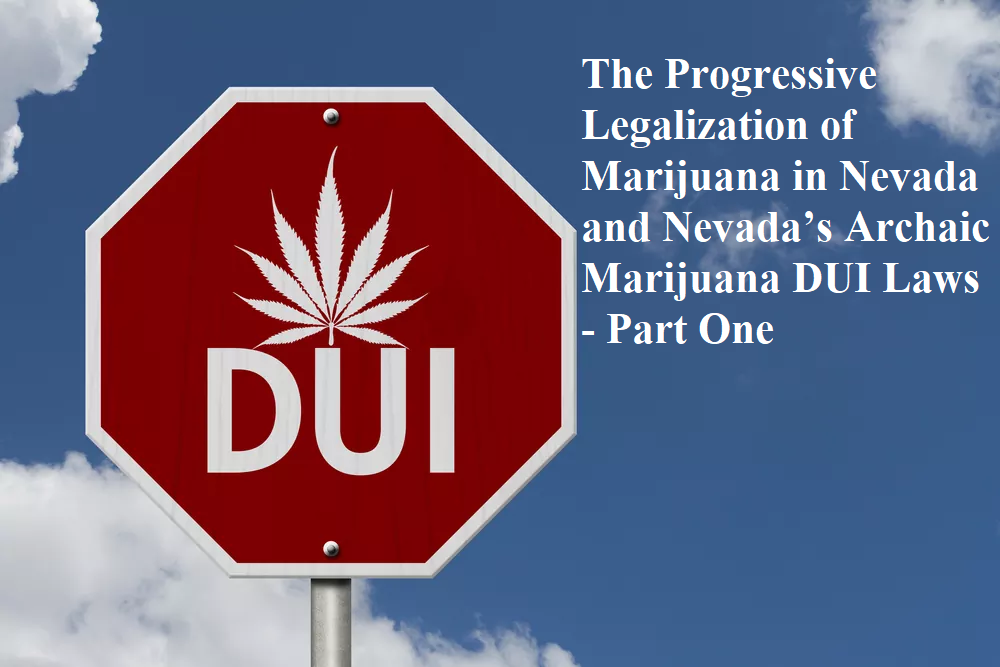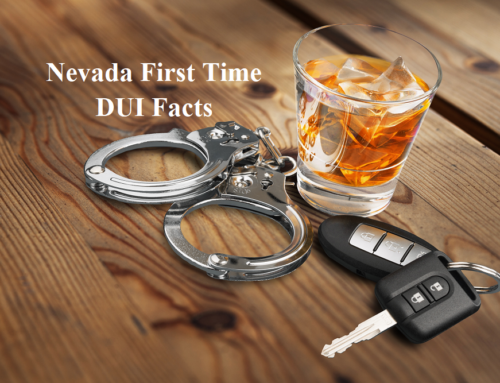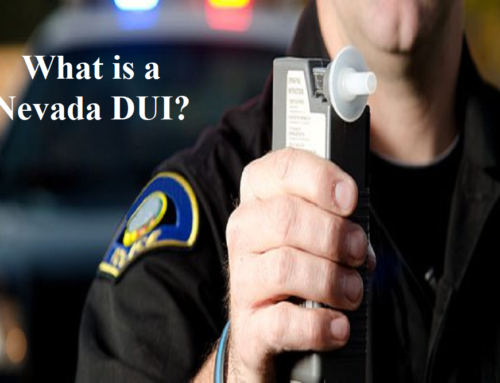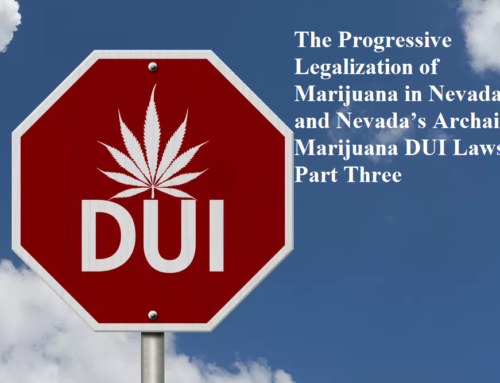So . . . it is now legal to recreationally use marijuana in the State of Nevada. How has the legalization of marijuana in Nevada impacted Nevada’s marijuana DUI laws? You should be disappointed to learn that it has not . . . or, at best, not really. I will explain why you should be disappointed in a moment. First, a brief history on Nevada’s marijuana and marijuana DUI laws may be useful.
A Brief History Regarding Nevada Marijuana Laws
Prior to January 1, 2017, it was illegal in Nevada to possess or use marijuana. In fact, most people then and now were/are shocked to learn that it was a felony to use marijuana prior to January 1, 2017.[1] Prior to the legalization of the recreational use of marijuana, Nevada’s marijuana DUI laws provided as follows:
[i]t is unlawful for any person to drive or be in actual physical control of a vehicle on a highway or on premises to which the public has access with an amount of a prohibited substance in his or her blood . . . that is equal to or greater than . . . [2 ng/ml of “marijuana” in the blood or 5 ng/ml of “marijuana metabolite” in the blood.] There were also per se levels for urine (marijuana and marijuana metabolite).
What you might not know is that the foregoing levels have been and are routinely attacked as having no correlation to impairment. In fact, in a study performed by the Washington State Patrol Forensic Laboratory Services Bureau, which was sponsored by the National Highway Traffic Safety Administration (“NHTSA”),[2] the authors concluded that based upon patterns of use and dosage, “[i]t is difficult to establish a relationship between a person’s THC blood or plasma concentration and performance impairing effects.”[3] Accordingly, the authors opined that “[i]t is inadvisable to try and predict effects based on blood THC concentrations alone . . .”[4] Significantly, the authors also opined that it is “impossible to predict specific effects based on THC-COOH concentrations.”[5]
The main isomer and principal psychoactive constituent of marijuana is Delta-9 tetrahydrocannabinol (THC). This is the component that gets you high. This is the “marijuana” that has a current per se blood level of 2 ng/ml. Your body then metabolizes THC down to its active metabolite of Hydroxy-THC (11-OH-THC). Research has shown that levels of Hydroxy-THC in the blood can also correlate to impairment. However, your body next metabolizes the Hydroxy-THC down to a secondary inactive metabolite commonly referred to as Carboxy-THC (THC-COOH). While Carboxy-THC is also a metabolite of THC, there is absolutely no empirical evidence tending to correlate levels of Carboxy-THC in the blood with impairment. In fact, quite the opposite; research establishes that Carboxy-THC remains in the blood for up to thirty days, depending on the individual’s frequency of use and dosage, a month after the high from THC has passed. Research shows that Carboxy-THC remains in habitual user’s blood for weeks and in occasional user’s blood for several days.[6] Still, Nevada’s marijuana-DUI law provided that an individual will be considered per se under the influence of marijuana if their blood contained 15 ng/ml or more of “marijuana metabolite,” which included Carboxy-THC.[7]
Your next questions should be Why did Nevada’s DUI laws criminalize conduct that is not DUI? Why has this law not been challenged and overturned? Actually, the foregoing levels of marijuana have been challenged as having no correlation to actual impairment. See Williams v. State, 118 Nev. 536, 50 P.3d 1116 (2002). In Williams, the Nevada Supreme Court upheld Nevada’s per se marijuana DUI laws. However, the Nevada Supreme Court did not uphold the laws because they determined that the prescribed per se levels correlated to impairment, but rather, because at the time the opinion was issued it was illegal to use marijuana. Accordingly, the Williams Court held that:
banning driving by persons with any measurable amount of illicit drugs was constitutional because ‘the legislature was reasonable in determining that there is no level of illicit drug use which can be acceptably combined with driving a vehicle; the established potential for lethal consequences is too great.’ Id., 118 Nev. at 543-44, 50 P.3d at 1121 (emphasis added), quoting State v. Phillips, 178 Ariz. 368, 873 P.2d 706, 710 (Ari.App. 1994).
In fact, citing to Williams, the Nevada Supreme Court recently recognized that Nevada’s marijuana-DUI law did not require impairment. See Sheriff, Clark County v. Burcham, 124 Nev. 1247, 1253, 198 P.3d 326, 330 (2008) at fn 13 (“explaining that NRS 484.3795(l)(f), which applies to a person who has a prohibited level of a controlled substance in his or her blood, does not require impairment . . .” (emphasis added), citing Williams, 118 Nev. at 548–49, 50 P.3d at 1124).
In other words, because using marijuana was illegal, setting per se levels for DUI-impairment, even where there was no correlation between the levels and actual impairment, would survive constitutional muster simply based upon the government’s interest in maintaining safe highways with no commentary on how punishing sober driving pursuant to an “under the influence” law maintains safer highways.
Flash Forward to January 1, 2017.
The recreational use of marijuana has been legalized in Nevada. The relevant statute, in pertinent part, provides “a person who is 21 years of age or older is exempt from state prosecution for . . . [t]he possession . . . or [use] . . . of cannabis.” It is legal for a person who is 21 years of age or older to “possess . . . one ounce of usable cannabis . . . at any one time.” Now . . . a reasonable person would presume that the legalization of marijuana would necessarily require an amendment to Nevada’s marijuana DUI laws. In fact, as just discussed, the Nevada Supreme Court has repeatedly upheld Nevada’s low level per se marijuana DUI laws simply because marijuana was illegal. Williams, 118 Nev. at 543-44, 50 P.3d at 1121 (emphasis added) (“banning driving by persons with any measurable amount of illicit drugs was constitutional because the legislature was reasonable in determining that there is no level of illicit drug use which can be acceptably combined with driving”); Burcham, 124 Nev. at 1253, 198 P.3d at 330 (emphasis added) (holding that Nevada’s per se marijuana DUI law “does not require impairment”).
It would make no sense to continue to criminalize unimpaired driving based upon threshold levels of a substance that can be lawfully consumed. Right? In fact, all of the other eighteen States/territories that have legalized the recreational use of marijuana have marijuana DUI laws that require actually proof of impairment (versus driving with some random level of THC that has no correlation to impairment in their blood) or have higher per se levels:
Alaska: no per se law; no per se metabolite law; must prove impairment (AS § 28.35.030(a)(1));
Arizona: no tolerance per se marijuana and metabolite[8] law (A.R.S. § 28-1381(A)(3); must prove impairment if driver holds medical marijuana card (A.R.S. § 36-2802(D));
California: no per se law; no per se metabolite law; must prove impairment (Cal. Veh. Code § 23152(f));
Colorado: no per se law; no per se metabolite law (C.R.S.A. § 42-4-1301(1)(a); 5 ng/ml or higher is a permissible inference of impairment (C.R.S.A. § 42-4-1301(6)(a)(IV);
Commonwealth of the Northern Mariana Islands: no per se law; no per se metabolite law; must prove impairment (9 CMC § 7105(a)(3));
District of Columbia: no per se law; no per se metabolite law; must prove impairment (DC ST § 50-2206.11(2));
Guam: no per se law; no per se metabolite law; must prove impairment (16 GCA § 18102(a));
Illinois: per se level of 5 ng/mL; no per se metabolite law (625 ILCS 5/11-501(a)(7); 625 ILCS 5/11-501.2(a)(6));
Maine: no per se law; no per se metabolite law; must prove impairment (29-A M.R.S.A. § 2411(1-A)(A)(1));
Massachusetts: no per se law; no per se metabolite law; must prove impairment (M.G.L.A. 90 § 24(1)(a)(1));
Michigan: no tolerance per se law unless driver holds medical marijuana card; no per se metabolite law[9]; if driver holds medical marijuana card must prove impairment (M.C.L.A. § 257.625(8));
Montana: per se level of 5 ng/ml; no per se metabolite law (MCA § 61-8-411(1)(a));
New Jersey: no per se law; no per se metabolite law; must prove impairment (C);
Nevada: per se law of 2 ng/mL; per se metabolite (Hydroxy-THC) law of 5 ng/mL NRS § 484C.110(4)(a)-(b));
Oregon: no per se law; no per se metabolite law; must prove impairment (O.R.S. § 813.010(1)(b));
South Dakota: no per se law; no per se metabolite law; must prove impairment (SDCL § 32-23-1(2); no tolerance per se law if driver under 21 years old (SDCL § 32-23-21(2)));
Vermont: no per se law; no per se metabolite law; must prove impairment (23 V.S.A. § 1201(a)(3));
Washington: per se level of 5 ng/ml; no per se metabolite law (RCWA § 46.61.502(1)(b)).
Thus, of the eighteen States and territories that have legalized marijuana, eleven require actual impairment to be proved in marijuana DUI cases. Colorado law provides for “a permissible inference of impairment” in cases involving 5 ng/mL or more of marijuana. Although six States (including Nevada) do have per se laws for marijuana, three of these States (Illinois, Montana and Washington) have a per se level that is 250% higher (5 ng/mL) than Nevada’s per se level (2 ng/mL). Moreover, although the two other States (Arizona and Michigan) have no tolerance per se laws (meaning any detectable amount), both States have exceptions that require impairment to be proved if the driver holds a valid medical marijuana card. Next, other than Nevada, only one other State (Arizona) has a per se marijuana metabolite law (which, again, does not apply if the Arizona motorist holds a medical marijuana card). Nevada’s marijuana DUI laws are by far the harshest of all States/territories that have legalized the recreational use of marijuana. Worse, as set forth below, Nevada’s current per se levels for marijuana-DUI have absolutely no correlation to impairment.
[1] NRS § 453.411.
[2] NHTSA is a federal agency under the US Department of Transportation. Its involvement with DUI detection and investigation cannot be overstated. NHTSA, together with the International Association of Chiefs of Police, researched, studied, tested, directed and developed the nationally standardized protocols for both alcohol and drug DUI investigations in the United States. On its website, NHTSA boasts: “NHTSA employs scientifically sound methods to ensure the quality and integrity of data underpinning our regulations and policies.” https://www.nhtsa.gov/about-nhtsa/nhtsas-core-values, accessed March 21, 2021.
[3] Fiona Couper, Ph.D. and Barry Logan, Ph.D. Drugs and Human Performance Fact Sheets DOT HS 809 725 April 2004, p. 8.
[4] See id., p. 9.
[5] See id.
[6] Musshoff F., Madea B. (2006). Review of biological matrices (urine, blood, and hair) as indicators of recent or ongoing cannabis use. Therapeutic Drug Monitoring, 28:155-63.
[7] Nevada’s previous “marijuana metabolite” DUI law did not differentiate between Hydroxy-THC and Carboxy-THC. In fact, if you are a DUI practitioner, take a look at your past 10 toxicology reports from your marijuana-DUI cases. The metabolite the government screens and reports is Carboxy-THC, not Hydroxy-THC.
[8] The Supreme Court of Arizona has held that Carboxy–THC, although a metabolite of marijuana, cannot be the basis for a DUI prosecution under the per se metabolite law because Carboxy-THC does not cause impairment. State ex rel. Montgomery v. Harris, 234 Ariz. 343, 347, 322 P.3d 160, 164 (2014).
[9] People v. Feezel, 486 Mich. 184, 211, 783 N.W.2d 67, 83 (2010).
***This article has been broken up into three (3) parts. This concludes the end of part one (1).***






